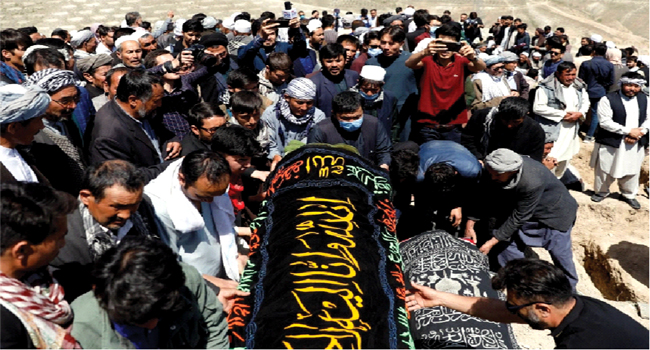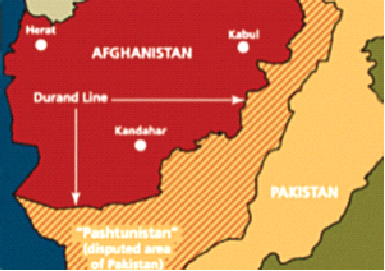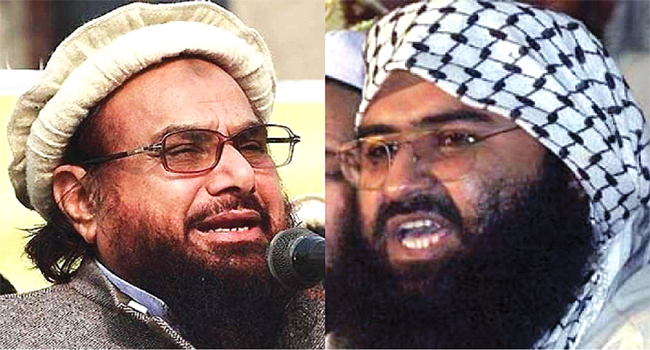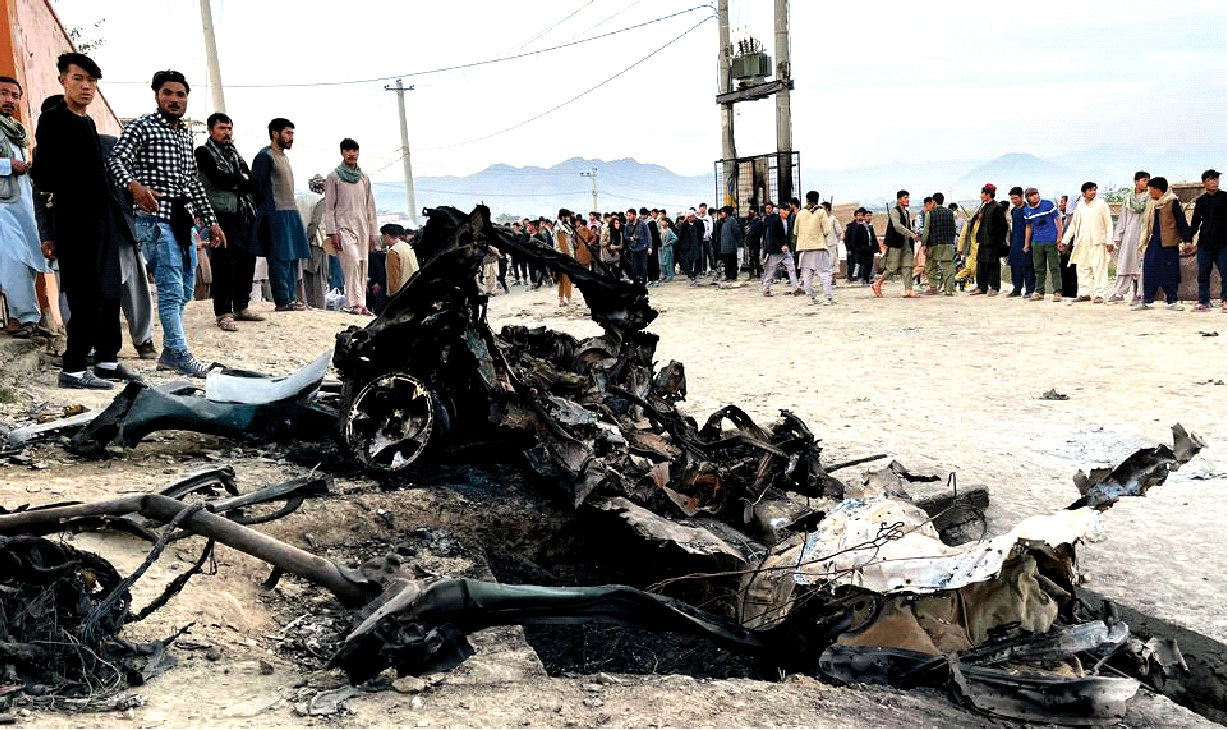The current condition in Afghanistan is very fluid. Most likely Afghanistan is heading towards a civil war. This could be detrimental not only for Afghans but for Pakistanis too. The economic sanctions against Pakistan by the UN have not been lifted. Its own share of power will be in deep trouble in future
-Satish Kumar

Afghans prepare victims’ coffins for a mass funeral ceremony after a recent explosion in Kabul
The US troops withdrawal from Afghanistan and strategic gain of Taliban seems to be a victory for Pakistan. It seemed like a short term gain. The speedy withdrawal of the US troops from Afghanistan has been matched by the swift advance of the Taliban across the nation.
Taliban leadership has claimed that it is in control of 85 per cent of the Afghan territory. Whether the Taliban claims are accurate or not, there is no doubt that it is gaining military ground. The US army camp and arsenals were being captured by the Taliban. The peripheral areas are under Taliban dominance, but major urban areas are out of its control. It should not be forgotten that during the first phase of Taliban rule major cities were out of its control. The fact of the matter is that Taliban and Pakistan are in cohorts.
Pakistan has not merely engineered the Doha Peace Deal but nurtured and guided the Taliban during the American onslaught since 2001. The current Chinese role in Afghanistan was a positive factor in favour of Pakistan. The Inter-State Intelligence (ISI) is the main body of Pakistan which trained and strategised Taliban. Therefore, it is quite natural to see that the future roadmap of Afghanistan is going to be designed by Pakistan’s military and ISI. But that is surface reality. The inner dynamics look different. In the long route, Pakistan seems to be pushing itself in a quagmire of trouble and miseries. There are solid reasons to establish this truth.
Pakistan-Afghanistan relations had not been very cordial. Both countries were on verge of war twice in the 1960s and the 1970s on the issue of boundary disputes. The Afghanistan-Pakistan boundary is almost 2,600 km long. It is called the Durand Line. Afghanistan never recognised this boundary line. Pakistan government has been fencing the boundary since 2017 which was opposed by Afghanistan. The Pashtun factor is another canker in the bilateral ties. There is a bad Taliban and a good Taliban for Pakistan. The bad Taliban is considered Tehreek-e-Taliban Pakistan (TTP) which has strong sanctuaries in Afghanistan.
The current external powers like China and Russia which are supporting Pakistan, have been very apprehensive of Islamic terror outfits. The drama is scripted to large extent by Pakistan but actors who are in lead roles in the game are not under the control of Pakistan.
There is a great possibility that ensuing civil war type conditions in Afghanistan will spin out from the basket and hit Pakistan badly.
Let us examine each factor in detail. Rawalpindi worries about the danger of the conflict spilling over to the east of the Durand Line, and hostile groups like the TTP gaining sanctuaries in Afghanistan. Pakistan, which shares a 2,611-km border with Afghanistan. The Pakistani Taliban, called the TTP, which operate in the country’s Northwestern region. The Pakistani army had forced the TTP fighters to retreat, but they are now feeling emboldened by the changing dynamics in Afghanistan. Since the start of the year, the TTP has claimed 32 attacks inside Pakistan. A UN report last year stated that more than 6,000 TTP fighters had taken refuge in Afghanistan. Pakistan, which helped the Taliban rise to power in the 1990s, is now worried about a resurgence of the TTP, a group that has been blamed for 70,000 deaths of civilians in the country since the U.S. invasion of Afghanistan in 2001.

TTP may see an opportunity to attack Chinese projects to influence policy in Islamabad. As the Taliban makes gains, many Afghans are fleeing villages for the relative safety of bigger cities. Pakistan expects 500,000 refugees from Afghanistan, and authorities have said they will be kept in border camps. More than 1.4 million registered Afghan refugees are already in Pakistan, according to the United Nations High Commissioner for Refugees. Not merely refugee camps are going to be eye shore for Pakistan military but many of the TTP fighters will move in disguise as a refugee. This could trigger incessant terrorist attacks in different places of Pakistan including Chinese projects. The CIPEC could be the prime target. It will have a chain reaction for Pakistan. So far, Pakistan had assured China that Pakistan driven outfits will never target China’s Muslim dominated areas of Xinjiang nor will it challenge Chinese authority in CIPEC.
Secondly, the Durand Line issue has continued to complicate the unpredictable nature of the Afghan-Pakistani relationship since the birth of Pakistan. No Afghan government, including the present one headed by President Ashraf Ghani, has ever recognised the legitimacy of the Durand Line, which runs through mountainous terrain and remains largely unpoliced. The Durand Line, which is viewed by many Afghans as an arbitrary and nonsensical reflection of geography, history, and culture, is an existential issue for Pakistan.

Founder of LeT Hafiz Saeed( L) and JeM Masood Azhar (R) are known
for creating trouble in neighbouring countries
for creating trouble in neighbouring countries
Recent Pakistani attempts to establish fences and border posts along the disputed border have been met with stiff resistance from Afghanistan. This aspect is generating much controversy post 1947.
Over a period of time, numerous studies suggest that the Durand line is legally void.
Hence Pakistan has no legal right to control over the territories, which Afghanistan considers as its own. The demand by millions of Pashtuns under the title of Pashtun
Tahfuz Movement (PTM) led by Manzoor Ahmad Pashteen for the formation of Great Afghanistan with the unification of Pashtuns and Balochs living on the other side of Durand Line has alarmed Pakistan. This will be a major concern for Pakistan in the future as well.
The Pakistan scheming of Islamic fervour will not have historical animosity. Afghanistan is fundamentally a tribal state not an Islamic or Nation-State. The different tribal communities had lived with their existing differences.
Third, Pakistan’s Northwest Frontier Province and tribal areas probably will continue to be poorly governed and the source or supporter of cross-border instability. With a population of about 39 million and growing at 2.33 per cent annually, it has a GDP of $19 billion, placing it among the world’s poorest countries. It ranks 173 out of 177 in the world HDI rankings. Almost 45 per cent of the GDP is due to grants from America and its allies, Saudi
Arabia and some from even countries like India. Afghanistan’s own revenues are less than 10 per cent of its GDP. The other numbers in Afghanistan are equally distressing. In 2015, the country produced nearly 7,000 tons of opium and converted almost 670 tons of heroin.
Afghanistan now produces 87 per cent of the world’s heroin. Pakistan’s strategy of terror will derail Afghanistan’s economic and social status post US withdrawal. Neither America nor India is going to pump money to revamp the gap. Chinese support is limited to its strategy and connectivity for CIPEC. Therefore, second phase of Taliban rule under the supervision of Pakistan is set to be disastrous for South Asia in general and Pakistan in particular.
There is a huge youth population. Majority of them are unemployed. So, youth could be cannon for unrest and political turmoil. Fourth, Taliban has close links with as many as 20 terror groups who operate across the region from Russia to India. Their activities are already visible on the ground, and they pose a significant threat to the region. The resulting Kingdom of Afghanistan was and remains ethnically, linguistically, and religiously diverse. Today, Pashtuns are the largest ethnic group within the country, but they represent only 38 per cent of the population. An almost equal number of Pashtuns live across the border in Pakistan and Northwest Frontier Province. Ethnic Tajiks comprise a quarter of the population. The Hazaras, who generally inhabit the center of the country, represent another 19 per cent. Other groups—such as the Aimaks, Turkmen, Baluch and Uzbek—comprise the rest. In addition to Dari (the Afghan dialect of Persian that is the lingua franca of half the population) and the Pushtun’s own Pashto, approximately ten per cent of the population.

People stand at the site of a blast in Kabul
Fifth, neither Moscow nor Beijing would want to see Afghanistan becoming the nursery of international terror again under the Taliban. For China, potential Taliban support to the Xinjiang separatist groups are a major concern. Russia does not want unrest to percolate down in Central Asian states. Afghanistan shares its boundaries with three of Central Asian states. Tehran cannot ignore the Sunni extremism of the Taliban and its oppressive record in dealing with the Shia and Persian-speaking minorities. America has left but still holds the sway. If things become worse American pressure tactics can twist Pakistan’s arms.
Finally, the contradiction between the interests of Afghanistan and Pakistan is an enduring one. While many in Pakistan would like to turn Afghanistan into a protectorate, Afghans deeply value their independence. All Afghan sovereigns, including the Taliban, will inevitably look for partners to balance Pakistan.
The current condition is very fluid. Most likely Afghanistan is heading towards a civil war.
This could be detrimental not only for Afghans but for Pakistanis too. The economic sanctions against Pakistan by the UN have not been lifted. Pakistan is looking to minimise the role of India in Afghanistan. But its own share of power will be in deep trouble in future.
Pakistan is on the highway of a suicidal death. Thousands of Pakistani terrorists from Lashkar-e-Taiba, Jaish-e-Mohammed and other groups are currently fighting alongside the Taliban in Afghanistan in a clear violation of the 2020 peace deal signed by the Taliban and the US, according to reports from security agencies. A majority of the LeT and JeM fighters are active in Kunar and Nangarhar provinces in eastern Afghanistan and Helmand and Kandahar provinces in the country’s southeast. Terrorist fighters from other Pakistan-based groups such as Tehrik-e-Taliban Pakistan, Lashkar-e-Jhangvi, Jamaat-ul-Arhar, Lashkar-e-Islam and al-Badr have also been spotted fighting alongside the Taliban. Pakistani terrorists have also been sighted in Ghazni, Khost, Logar, Paktia and Paktika provinces in south and southeast Afghanistan.
(The writer is lecturer in Political Science, IGNOU, New Delhi)














Comments